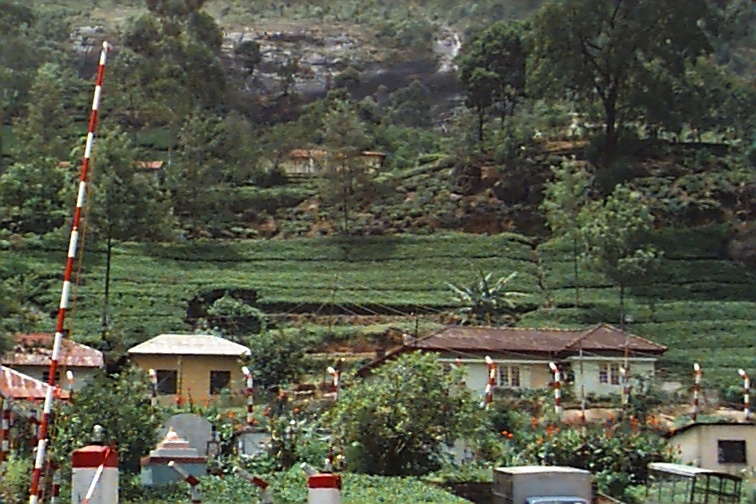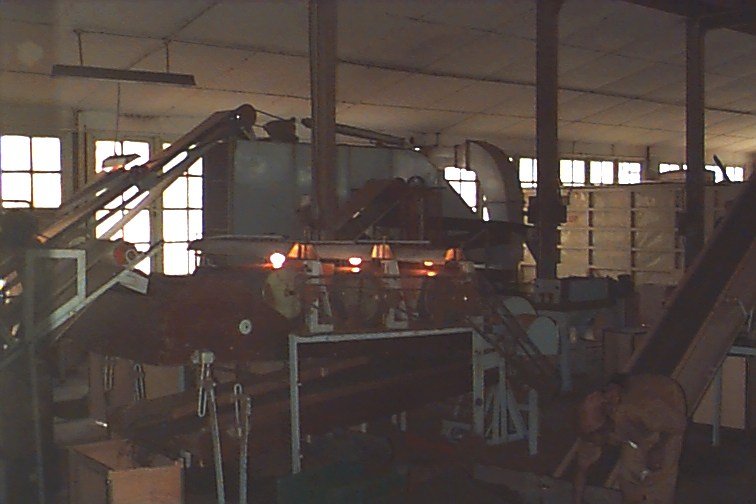Nuwara Eliya: The La Bookellie
Tea
Plantation

 No trip to Sri Lanka is
truly complete
without a trip to Nuwara Eliya, the central highlands and home of the
tea plantations. A favorite of ours is the Labookellie Tea Plantation,
and we never leave the island without a year's supply of their
exquisite tea. The trip to Labookellie and Nuwara Eliya is about four
hours or more from Kandy, on narrow and twisting roads. It is about as
harrowing as a ride down the Galle Road, but in a different way; here
your worries are altitude and gravity rather than maniac drivers
(although you may encounter of few of those as well) As you wind
your way into the mountains, you will begin to spot the terraced
grooves in the greenery that indicate tea fields (photo above left). Soon we arrived at the gates to the
Labookellie
Tea Factory (shown in the photo to the right) a remarkably compact
compound of corrugated buildings; in contrast to the sprawling hillside
fields, the manufacturing process is essentially completed in two
buildings. The company offers a very informative tour of the plant,
which begins with showing samples of the different grades of tea
produced, ranging from regular to tea that is so fine it would pass
through the openings in an ordinary tea ball to larger cut teas.
In addition to the fineness of the cut, there is the matter of quality
and taste. At Labookellie it
No trip to Sri Lanka is
truly complete
without a trip to Nuwara Eliya, the central highlands and home of the
tea plantations. A favorite of ours is the Labookellie Tea Plantation,
and we never leave the island without a year's supply of their
exquisite tea. The trip to Labookellie and Nuwara Eliya is about four
hours or more from Kandy, on narrow and twisting roads. It is about as
harrowing as a ride down the Galle Road, but in a different way; here
your worries are altitude and gravity rather than maniac drivers
(although you may encounter of few of those as well) As you wind
your way into the mountains, you will begin to spot the terraced
grooves in the greenery that indicate tea fields (photo above left). Soon we arrived at the gates to the
Labookellie
Tea Factory (shown in the photo to the right) a remarkably compact
compound of corrugated buildings; in contrast to the sprawling hillside
fields, the manufacturing process is essentially completed in two
buildings. The company offers a very informative tour of the plant,
which begins with showing samples of the different grades of tea
produced, ranging from regular to tea that is so fine it would pass
through the openings in an ordinary tea ball to larger cut teas.
In addition to the fineness of the cut, there is the matter of quality
and taste. At Labookellie it 
 appears that the quality of the tea is the
degree to which the best tea leaves are cut with lesser varieties. In
fact, one reason for visiting the factory is that the purest tea is
only sold there; by the time it reaches Colombo it is already cut with
lesser quality leaves. And there is a similar meritocracy to the export
of tea. The finest teas get shipped to those countries who are the
keenest tea drinkers, while the countries who are predominantly coffee
drinkers (especially the strong cardamom-based coffees of the Middle
East) are shipped the lesser quality teas; the Sri Lankans clearly
believe such strong coffee consumption
irreparably damages the taste buds, and they point to the sweepings at
the bottom of the bins of tea as the
sort of
leaves they sell to those nations that don't appreciate the quality of
their product! Making tea appears to
be a fairly
arduous process of fermentation and drying, and visitors are treated to
a tour of the process. Judging from the age of the machinery, it is
apparent that the technique for making tea has not changed appreciably
in years. The first stop is the drying and fermentation stations where
the tea is initially processed. The photo in the middle left shows the
main tea processing building, while the photo in the middle right
captures the first step in tea manufacturing, withering the
freshly-picked leaves and sending them on for
appears that the quality of the tea is the
degree to which the best tea leaves are cut with lesser varieties. In
fact, one reason for visiting the factory is that the purest tea is
only sold there; by the time it reaches Colombo it is already cut with
lesser quality leaves. And there is a similar meritocracy to the export
of tea. The finest teas get shipped to those countries who are the
keenest tea drinkers, while the countries who are predominantly coffee
drinkers (especially the strong cardamom-based coffees of the Middle
East) are shipped the lesser quality teas; the Sri Lankans clearly
believe such strong coffee consumption
irreparably damages the taste buds, and they point to the sweepings at
the bottom of the bins of tea as the
sort of
leaves they sell to those nations that don't appreciate the quality of
their product! Making tea appears to
be a fairly
arduous process of fermentation and drying, and visitors are treated to
a tour of the process. Judging from the age of the machinery, it is
apparent that the technique for making tea has not changed appreciably
in years. The first stop is the drying and fermentation stations where
the tea is initially processed. The photo in the middle left shows the
main tea processing building, while the photo in the middle right
captures the first step in tea manufacturing, withering the
freshly-picked leaves and sending them on for

 fermentation. The next step in the process is the
rolling and
fermentation station, shown in the photo to the lower left. At this
point the fermented morass of leaves is rolled flat and broken into the
bits that you see in your loose-leaf tea or tea bags. Next, the rolled
tea is send to the grading room, where the finished product is graded
by quality and sent in batches for the final bagging and boxing. The
grading room is shown in the photo at the bottom right. And the end
result? Just about the richest and most drinkable tea to fill a pot!
fermentation. The next step in the process is the
rolling and
fermentation station, shown in the photo to the lower left. At this
point the fermented morass of leaves is rolled flat and broken into the
bits that you see in your loose-leaf tea or tea bags. Next, the rolled
tea is send to the grading room, where the finished product is graded
by quality and sent in batches for the final bagging and boxing. The
grading room is shown in the photo at the bottom right. And the end
result? Just about the richest and most drinkable tea to fill a pot!

Return to Sri Lanka
Main
Page

 No trip to Sri Lanka is
truly complete
without a trip to Nuwara Eliya, the central highlands and home of the
tea plantations. A favorite of ours is the Labookellie Tea Plantation,
and we never leave the island without a year's supply of their
exquisite tea. The trip to Labookellie and Nuwara Eliya is about four
hours or more from Kandy, on narrow and twisting roads. It is about as
harrowing as a ride down the Galle Road, but in a different way; here
your worries are altitude and gravity rather than maniac drivers
(although you may encounter of few of those as well) As you wind
your way into the mountains, you will begin to spot the terraced
grooves in the greenery that indicate tea fields (photo above left). Soon we arrived at the gates to the
Labookellie
Tea Factory (shown in the photo to the right) a remarkably compact
compound of corrugated buildings; in contrast to the sprawling hillside
fields, the manufacturing process is essentially completed in two
buildings. The company offers a very informative tour of the plant,
which begins with showing samples of the different grades of tea
produced, ranging from regular to tea that is so fine it would pass
through the openings in an ordinary tea ball to larger cut teas.
In addition to the fineness of the cut, there is the matter of quality
and taste. At Labookellie it
No trip to Sri Lanka is
truly complete
without a trip to Nuwara Eliya, the central highlands and home of the
tea plantations. A favorite of ours is the Labookellie Tea Plantation,
and we never leave the island without a year's supply of their
exquisite tea. The trip to Labookellie and Nuwara Eliya is about four
hours or more from Kandy, on narrow and twisting roads. It is about as
harrowing as a ride down the Galle Road, but in a different way; here
your worries are altitude and gravity rather than maniac drivers
(although you may encounter of few of those as well) As you wind
your way into the mountains, you will begin to spot the terraced
grooves in the greenery that indicate tea fields (photo above left). Soon we arrived at the gates to the
Labookellie
Tea Factory (shown in the photo to the right) a remarkably compact
compound of corrugated buildings; in contrast to the sprawling hillside
fields, the manufacturing process is essentially completed in two
buildings. The company offers a very informative tour of the plant,
which begins with showing samples of the different grades of tea
produced, ranging from regular to tea that is so fine it would pass
through the openings in an ordinary tea ball to larger cut teas.
In addition to the fineness of the cut, there is the matter of quality
and taste. At Labookellie it 
 appears that the quality of the tea is the
degree to which the best tea leaves are cut with lesser varieties. In
fact, one reason for visiting the factory is that the purest tea is
only sold there; by the time it reaches Colombo it is already cut with
lesser quality leaves. And there is a similar meritocracy to the export
of tea. The finest teas get shipped to those countries who are the
keenest tea drinkers, while the countries who are predominantly coffee
drinkers (especially the strong cardamom-based coffees of the Middle
East) are shipped the lesser quality teas; the Sri Lankans clearly
believe such strong coffee consumption
irreparably damages the taste buds, and they point to the sweepings at
the bottom of the bins of tea as the
sort of
leaves they sell to those nations that don't appreciate the quality of
their product! Making tea appears to
be a fairly
arduous process of fermentation and drying, and visitors are treated to
a tour of the process. Judging from the age of the machinery, it is
apparent that the technique for making tea has not changed appreciably
in years. The first stop is the drying and fermentation stations where
the tea is initially processed. The photo in the middle left shows the
main tea processing building, while the photo in the middle right
captures the first step in tea manufacturing, withering the
freshly-picked leaves and sending them on for
appears that the quality of the tea is the
degree to which the best tea leaves are cut with lesser varieties. In
fact, one reason for visiting the factory is that the purest tea is
only sold there; by the time it reaches Colombo it is already cut with
lesser quality leaves. And there is a similar meritocracy to the export
of tea. The finest teas get shipped to those countries who are the
keenest tea drinkers, while the countries who are predominantly coffee
drinkers (especially the strong cardamom-based coffees of the Middle
East) are shipped the lesser quality teas; the Sri Lankans clearly
believe such strong coffee consumption
irreparably damages the taste buds, and they point to the sweepings at
the bottom of the bins of tea as the
sort of
leaves they sell to those nations that don't appreciate the quality of
their product! Making tea appears to
be a fairly
arduous process of fermentation and drying, and visitors are treated to
a tour of the process. Judging from the age of the machinery, it is
apparent that the technique for making tea has not changed appreciably
in years. The first stop is the drying and fermentation stations where
the tea is initially processed. The photo in the middle left shows the
main tea processing building, while the photo in the middle right
captures the first step in tea manufacturing, withering the
freshly-picked leaves and sending them on for

 fermentation. The next step in the process is the
rolling and
fermentation station, shown in the photo to the lower left. At this
point the fermented morass of leaves is rolled flat and broken into the
bits that you see in your loose-leaf tea or tea bags. Next, the rolled
tea is send to the grading room, where the finished product is graded
by quality and sent in batches for the final bagging and boxing. The
grading room is shown in the photo at the bottom right. And the end
result? Just about the richest and most drinkable tea to fill a pot!
fermentation. The next step in the process is the
rolling and
fermentation station, shown in the photo to the lower left. At this
point the fermented morass of leaves is rolled flat and broken into the
bits that you see in your loose-leaf tea or tea bags. Next, the rolled
tea is send to the grading room, where the finished product is graded
by quality and sent in batches for the final bagging and boxing. The
grading room is shown in the photo at the bottom right. And the end
result? Just about the richest and most drinkable tea to fill a pot!
